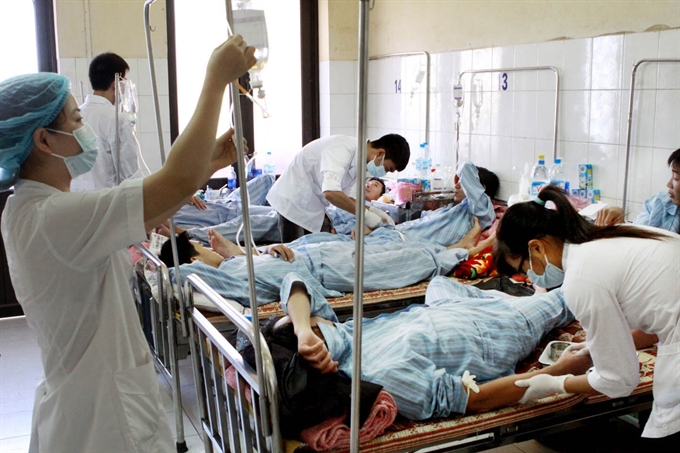 Society
Society

Trần Đắc Phu, director of the Ministry of Health’s Preventive Heath Department, has warned that the dengue fever would continue to spread this year as an effect of the El Nino phenomenon and the cyclical nature of the disease, re-appearing every five years.
 |
| Doctors treat patients for dengue fever in the Hà Nội-based National Hospital of Tropical Diseases. The dengue fever is predicted to spread due to the El Nino phenomenon and the cyclical nature of the disease, a medical official says.— VNA/VNS Photo Dương Ngọc |
HÀ NỘI — Dengue fever has overloaded hospitals in the Tây Nguyên (Central Highlands) and threatened other localities, and health experts said that the mosquito-borne disease is unlikely to be under control very soon.
Trần Đắc Phu, director of the Ministry of Health’s Preventive Heath Department, has warned that the dengue fever would continue to spread this year as an effect of the El Nino phenomenon and the cyclical nature of the disease, re-appearing every five years.
Statistics from the Ministry of Health showed that Việt Nam has so far this year recorded 49,049 cases of dengue fever across the country. There have been a total of 17 deaths.
The infected cases occurred in 48 provinces and cities including Khánh Hòa, Bình Định, Phú Yên, Đà Nẵng, HCM City, Bình Phước, Đắk Lắk, Gia Lai , Kon Tum and Đắk Nông.
The Central Highlands region accounted for about half of the total infection cases.
Phu blamed the outbreak of the disease to the fact that it was rainy season in the Central Highlands. The number of dengue cases reached its peak at the end of last year and decreased during the first months of this year.
The prolonged drought this year has forced local residents to store water in open water containers, providing perfect conditions for the development of mosquito larvae.
Additionally, dengue fever hasn’t been widespread in the Central Highlands region over the past few years. Thus, low immunity to the disease has contributed to its rapid infection rate.
The rocketing number of dengue fever infections has overloaded hospitals in the region.
Hospitals in Gia Lai Province have been struggling with large numbers of over 3,379 infected cases.
Reports from Gia Lai Province’s Health Department found that 115 new cases were detected in a single day.
“Two patients had to share a bed and even sleep in the hospital corridors but that’s not enough, said Rcom Manh, from Gia Lai General Hospital.
The same situation has been reported in Kon Tum Province which recorded an average of 30 cases of dengue fever admitted to the hospital a day.
Since the beginning of this year, 1,800 dengue cases have been reported in Kon Tum Province, including two dead.
“Many people in my village suffered from dengue fever. Children and elderly are among those who continuously register at a hospital,” said Nguyễn Thị Hồng, who lives in Đăk Hà District’s Đăk Hrinh Commune.
Nguyễn Lộc Vương, director of Kon Tum Province’s Health Preventive Centre, attributed the high rate of infections to local people’s negligence to disease prevention.
Many residents were not aware of the risk of having open containers of water in their homes which were ideal places for mosquitoes to lay eggs, he said.
To strengthen dengue fever prevention work, the Ministry of Health has allocated VNĐ2 billion (US$89,660) and granted an additional 1,200 litres of chemicals to kill mosquitoes in four Central Highlands provinces which were seriously hit by the disease.
Phu called on People’s Committees and relevant offices to take measures to prevent the spread of the disease such as cleaning up living environments, spraying mosquito repellents and asking people to use mosquito nets while sleeping.
To reduce the mosquito population, it is necessary for people to get rid of places where mosquitoes can breed, he said. These include old tires, cans or flower pots that collect rain.
In HCM City, health authorities have warned that a dengue-fever outbreak could occur in the next two months when the disease reaches its peak.
Last week, a 43-year-old woman in Hóc Môn District died of dengue fever, the second dengue-fever related death in the city this year.
In May, a resident in Gò Vấp District also died of dengue fever.
In July, an average of 200 people were hospitalised weekly for dengue fever treatment, according to a report released by the city’s Preventive Medicine Centre.
Nearly 7,210 people have been hospitalised for treatment of dengue fever so far this year, an increase of 89 per cent compared to the same period last year.
The high-risk spots are concentrated in Bình Chánh, Hóc Môn and Thủ Đức districts.
Nguyễn Trí Dũng, director of the city’s Preventive Medicine Centre, has asked district-level preventive medicine officials to take urgent measures to kill mosquitoes and larvae to prevent a large-scale outbreak.
The city’s Department of Health has also called for preventive actions in the community such as spraying, emptying of water containers and prevention of mosquito bites. — VNS




